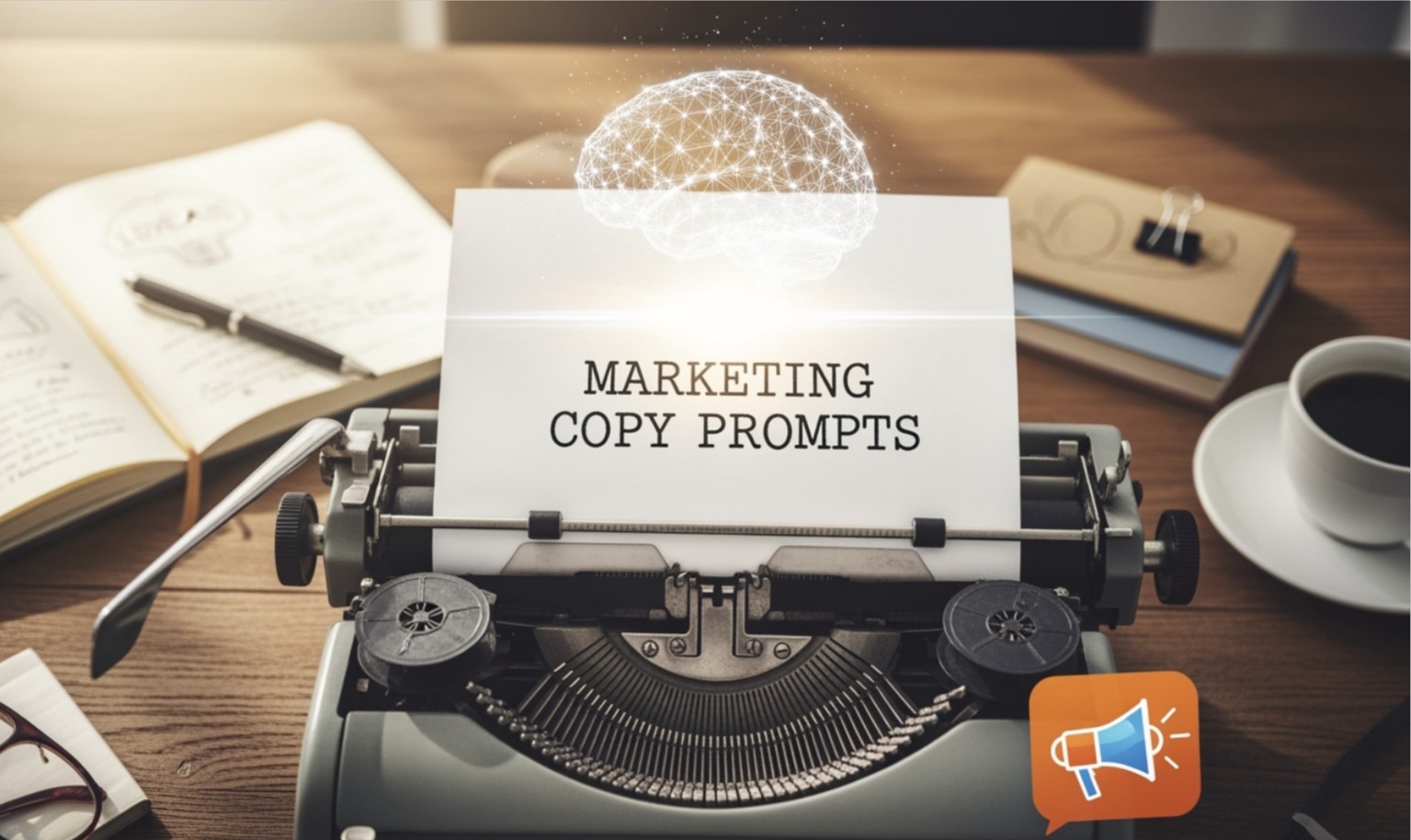From Blank Page to Brilliance: Your Guide to High-Impact Marketing Prompts
Opening Up Your Copywriting Potential with Prompts.

What are marketing copy prompts? They are structured cues designed to guide copywriters in creating effective, persuasive content. These tools help overcome creative problems and streamline the writing process. They can help you:
- Overcome writer's block with foundational exercises.
- Empathize with customers using frameworks like the Pain-Problem-Pain Loop.
- Turn features into customer-centric benefits.
- Leverage AI effectively with formulas like PAS and AIDA.
- Tailor content for social media, ads, email, and video.
- Gain strategic insights with advanced prompts.
Writer’s block is a major challenge, especially with deadlines looming. Even professionals using AI can struggle to craft effective prompts. In a noisy digital world where consumers see hundreds of ads daily, sharp, compelling copy is essential. This is where marketing copy prompts come in.
These prompts are your secret weapon to conquer the blank page, understand customer needs, and transform features into irresistible benefits. This guide will show you how to use everything from traditional techniques to AI-driven solutions to create high-converting marketing copy.

Kickstart Your Creativity: Foundational Copywriting Exercises

Before diving into AI, let's build a strong foundation. These classic marketing copy prompts and exercises are timeless tools that sharpen your skills, help you understand your audience, and banish writer's block.
Define Your Core Message with a USP Generator
Your Unique Selling Proposition (USP) is what makes your product special. It’s the big promise that sets you apart. To find your USP, use this prompt:
"Our product/service, [Product], helps [audience] with/who [problem] achieve/get [benefit] through [unique solution]."
For example: "Our coaching program helps aspiring copywriters who struggle with writer's block achieve a consistent creative flow through our proprietary prompt-based exercises." This clearly defines who you help, their problem, the benefit, and your unique approach.
Empathize with the Pain-Problem-Pain Loop
To connect with your audience, you must understand their struggles. The problem is what is happening; the pain is how it makes them feel. People are often more driven to avoid pain than to gain pleasure, making this loop effective for sales copy.
Here's the formula:
"You are [negative emotion/pain] because [specific problem] and, as a result, you [negative emotion/pain]."
For a weight loss product, instead of "You're overweight," try: "You are frustrated because your favorite clothes don't fit, and as a result, you feel ashamed to go out with friends." This taps into the customer's emotional journey.
Convert Features into Benefits Customers Crave
Customers care about what your product does for them. Features are what your product is; benefits are what it means for the customer. To turn a feature into a benefit, ask yourself: What problem does this solve? What pain point does it address? Why does the customer truly need this?
For a quick win, use the phrase "So you can..." For example, a feature like "batteries included" becomes a benefit: "so you can start playing immediately."
Release Your Ideas with the 'No-Delete-Cheat-Sheet'
Staring at a blank page? Your inner critic might be stopping you. The 'No-Delete-Cheat-Sheet' is a freewriting technique to get your creative juices flowing. The rules are simple:
- Write for 10-20 minutes without stopping.
- Do not hit the delete key. No matter what.
- Let your thoughts spill onto the page.
This exercise helps you bypass self-censorship, allowing raw ideas to surface. It's a great brainstorming tool to generate material you can refine later.
Hone Your Skills with the 'Copy Cat' Exercise
Learning from the best is smart. The 'Copy Cat' exercise helps you improve by studying great marketing copy. It's about reverse-engineering brilliance, not stealing it.
Find a piece of marketing copy you admire, then:
- Handwrite sentences from it. This can boost creativity and memory.
- Rewrite those sentences in your own words, keeping the same impact.
This exercise helps you understand the structure and persuasive tricks behind effective copy, teaching you how to apply those principles to your own writing.
Level Up with AI: Crafting Your First Marketing Copy Prompts
Now that we've sharpened our foundational skills, let's see how AI can amplify your creative potential. Potions AI is changing prompt engineering from a solo struggle into a collaborative art, helping you generate compelling content with incredible speed.
The Anatomy of a High-Converting AI Prompt
Getting great output from AI requires clear instructions. A well-constructed AI prompt has five key ingredients:
- Ad Subject: What are you promoting and what is its main value?
- Unique Selling Points (USPs): What makes your offer stand out?
- Target Audience: Who are you talking to? Define their demographics, interests, and pain points.
- Content Goal: What do you want people to do? (e.g., conversions, leads, engagement).
- Tone: How should the copy sound? (e.g., informative, enthusiastic, humorous).
Instead of a vague prompt like "Write an ad for running shoes," try this: "Create a social media ad for our new eco-friendly running shoes. Emphasize their sustainable materials and superior comfort. Target eco-conscious runners aged 25-45. The goal is to drive website clicks for purchase. Use an inspiring and adventurous tone." This level of detail gives the AI everything it needs.
Weaving Classic Formulas (PAS & AIDA) into Your Prompts
Classic copywriting formulas are proven roadmaps for persuasive writing. You can instruct Potions AI to use them directly.
PAS (Problem, Agitate, Solution): This formula hooks your audience by highlighting a problem, agitating it, and then presenting your solution. Prompt the AI like this: "Write a short sales page using the PAS formula for [Product X]. Identify the problem of [specific problem], agitate it by describing [consequences], and present [Product X] as the solution."
AIDA (Attention, Interest, Desire, Action): This framework grabs Attention, builds Interest, sparks Desire, and pushes for Action. Prompt the AI: "Generate marketing copy for [Product Y] using the AIDA framework. Grab attention with [hook], build interest with [feature/benefit], create desire with [emotional appeal], and include a clear call to action to [desired action]."
Baking these formulas into your marketing copy prompts guides the AI to produce structured, persuasive content.
How to Generate Irresistible Calls to Action (CTAs)
A great Call to Action (CTA) is the bridge between your copy and a customer's action. Potions AI can help you craft irresistible CTAs by including specific elements:
- Directness: Use clear, active language ("Buy now").
- Interest: Make the CTA intriguing ("Open up your potential").
- Power Words: Use persuasive terms ("Instantly," "Find your freedom").
- Urgency: Create immediacy ("Limited time offer").
- Risk Removal: Alleviate hesitation ("30-day money-back guarantee").
Prompt the AI: "Generate 5 CTA variations for our [online course]. Include urgency, a power word, and a clear benefit. Make one direct, one intriguing, and one that removes risk." This allows you to A/B test different CTAs to see which performs best.
Advanced AI Prompts for Every Marketing Channel

Now it's time to open up AI's power across all your marketing efforts. The beauty of AI is its versatility, allowing you to tailor marketing copy prompts for every platform, from social media to email campaigns. This precision ensures your message resonates, no matter where your audience is. With nearly 90% of marketers attributing increased business exposure to social media, optimized content is crucial.
AI Prompts for High-Converting Social Media and Ad Copy
To get high-converting copy, you need to give AI instructions custom to each platform's vibe.
- Facebook: Focus on compelling storytelling. Prompt: "Write three engaging Facebook posts for [Product Z], targeting [demographic]. Focus on a relatable problem and offer [Product Z] as the solution. Include a clear CTA."
- Instagram: Captions should be short and punchy. Prompt: "Craft catchy Instagram captions for [Product A] focusing on [feature/benefit]. Use emojis and relevant hashtags."
- LinkedIn: Content needs to be insightful and value-driven. Prompt: "Craft an appealing LinkedIn post promoting our [service] to [industry professionals]. Highlight its professional benefits and include a link to our [resource]."
- Email: AI can help with subject lines, body copy, and CTAs. Prompt: "Write three email subject lines and a short email body for a promotional campaign about [Product X]. Focus on urgency and the main benefit."
Repurposing Existing Content into Fresh Ad Campaigns
Get more mileage out of your existing content by using AI to transform it into fresh ad campaigns.
- Blog post to ads: "Rewrite key takeaways from this blog post about [topic] into three concise social media ads for [platform]. [Paste blog post content here]."
- Case study to ad copy: "Transform this case study about [client's success] into compelling ad copy. Extract the problem, solution, and quantifiable result. [Paste case study content here]."
- Testimonial to ad copy: "Convert this customer testimonial into a powerful ad for [platform]. Highlight the customer's initial pain and how our product provided relief. [Paste testimonial here]."
AI makes it easy to reshape long-form content into bite-sized, persuasive ad formats, saving you time and effort.
Generating Engaging Scripts for TikTok and YouTube
Video content is king. AI can help you craft engaging scripts for dynamic platforms like TikTok and YouTube.
- TikTok: Known for short, trend-driven videos. Prompt: "Write a 30-second TikTok script for [Product X]. Make it conversational, humorous, and highlight [key feature] with a visual idea."
- YouTube: Perfect for longer, in-depth content. Prompt: "Outline a 5-minute YouTube script for a tutorial on [Skill/Product Feature]. Include an engaging intro, step-by-step instructions, and a compelling outro with a CTA to subscribe."
Leveraging AI for Community Platforms (Reddit & Quora)
Engage with people on community platforms like Reddit and Quora by providing value, not just ads.
- Reddit: Thrives on authentic conversation. Prompt: "Develop 10 post ideas for the r/[specific subreddit] related to [your industry]. Focus on providing value or asking genuine questions, not overtly selling."
- Quora: A question-and-answer platform for establishing expertise. Prompt: "Write a detailed answer to the Quora question '[Paste Quora question here]'. Provide valuable information and subtly position our [product/service] as a helpful resource."
Beyond the Basics: Innovative Prompts to Boost Your Strategy

While many marketing copy prompts focus on content output, some are strategic powerhouses. These innovative prompts, boosted by AI, help you dig into data, fine-tune campaigns, and align long-term goals. Think of them as your secret weapon for a smarter marketing approach.
The 'Why I Bought' Cruncher for Voice of Customer Insights
Understanding why customers choose you is gold. This prompt sifts through customer feedback to pinpoint key reasons and hesitations, giving you powerful insights to sharpen your marketing messages.
Here’s how to use it: "Act as a marketing analyst. Analyze the following customer feedback. Identify the top 3 reasons customers purchased our [product], their primary hesitations, and any unexpected benefits. Suggest how to incorporate these insights into our marketing copy. [Paste customer feedback data]."
This prompt helps you pull actionable intelligence from raw customer data, allowing you to highlight what resonates and address concerns directly in your copy.
The Split Test Genie for Data-Driven Optimization
A/B testing boosts conversion rates, but coming up with good test ideas can be hard. The Split Test Genie prompt helps you create smart A/B testing plans for your landing pages.
Try this prompt: "You are a conversion rate optimizer. Create an A/B testing plan for our [landing page]. The goal is to increase [metric, e.g., sign-ups]. Focus on testing [element, e.g., headline]. Suggest 3-5 specific variations and explain the hypothesis for each."
This prompt helps you structure effective tests, ensuring your optimization efforts are backed by data, not just intuition.
The Value Prop Idea Generator for Clear, Compelling Messaging
In a crowded market, a clear value proposition is essential. This prompt is a great tool for crafting snappy, memorable statements that explain what makes you unique.
Here’s a prompt to get ideas flowing: "You are a brand strategist. Our [product] helps [target audience] solve [problem] by [unique solution]. Generate 10 catchy value propositions (headlines and subheads) that differentiate us from competitors."
As David Ogilvy noted, a sharp, defined personality is important. This prompt ensures your value proposition is relevant, valuable, and unique.
The Dream Day Script for Aligning Strategy with Vision
This strategic tool helps entrepreneurs visualize their ideal future. By creating a vivid picture, it guides you to build a schedule that aligns daily actions with long-term goals.
Try this prompt: "Describe your ideal 'dream day' one year from now, focusing on personal and professional achievements related to [your business]. Then, based on this vision, outline a weekly and daily schedule that would enable you to achieve this future."
This prompt encourages working smarter by connecting daily efforts directly to your bigger vision and strategic goals.
Frequently Asked Questions about Marketing Copy Prompts
As we accept AI in marketing, it's natural to have questions. Let's clear up some common concerns about using marketing copy prompts effectively.
What are the most common pitfalls to avoid when using AI for copywriting?
AI is a powerful tool, but there are common traps to avoid to ensure your content stays top-notch.
- Over-reliance on AI: It's a tool, not a replacement for your strategic thinking.
- Generic outputs: Vague prompts can lead to bland, unoriginal copy.
- Inaccuracy and fabrication: AI can "hallucinate" facts. Always fact-check its output.
- Lack of brand voice consistency: Without clear guidance, AI might create off-brand content.
- Ethical concerns: Be aware of potential biases in AI models.
- Data privacy: Be careful about putting sensitive information into public AI models.
How can I ensure my AI-generated content remains authentic and on-brand?
Keeping your AI-generated content authentic is crucial. Here’s how to ensure it reflects your brand's unique vibe:
- Provide ample context: Share client profiles, messaging guidelines, and examples of successful content. The more AI knows, the better it can mimic your style.
- Use specific tone prompts: Tell the AI exactly how to sound (e.g., "witty and conversational" or "authoritative but empathetic").
- Assign a role to the AI: Start your prompt with a role, like "You are an expert conversion copywriter..." to help it adopt the right perspective.
- Iterate and refine: Don't expect perfection on the first try. Give feedback and ask for variations.
- Human editing is essential: This is where you inject personality, add nuance, and ensure accuracy.
What are the main benefits of using AI for marketing copy?
The benefits of bringing AI into your marketing copy prompts workflow are significant, helping to streamline content creation.
- Efficiency and speed: AI can generate multiple copy variations in seconds, dramatically speeding up content creation and brainstorming.
- Overcoming writer's block: It acts as a brainstorming partner, providing ideas and starting points when you feel stuck.
- Idea generation: AI can suggest fresh angles, topics, and approaches you might not have considered.
- Personalization at scale: It can help tailor content for specific audience segments, leading to more relevant and effective marketing messages.
- A/B testing variations: AI can quickly generate numerous variations for headlines and CTAs, helping you optimize for conversions.
- Automation of tasks: It frees you up to focus on higher-level strategy and creative work.
Conclusion
From foundational exercises to leveraging AI for hyper-targeted campaigns, marketing copy prompts are a secret weapon for creating compelling content. By combining core copywriting principles with strategic AI prompting, you can transform your approach to content creation.
The journey from a blank page to brilliant marketing copy is now a collaborative process, improved by well-crafted prompts and intelligent tools like Potions AI. Traditional techniques like the Pain-Problem-Pain Loop work beautifully alongside modern AI capabilities.
What's most exciting is how these tools democratize great copywriting. Foundational exercises sharpen your instincts, while AI amplifies your creativity and efficiency. Time-tested formulas like PAS and AIDA become even more powerful when woven into AI prompts.
By embracing these techniques, you're not just improving your skills—you're contributing to a movement that's changing prompt engineering from a solo skill into a collaborative craft. Every prompt you create and refine adds to our collective understanding of what works.
Ready to take your copywriting to the next level? The world of AI-powered marketing copy is waiting.